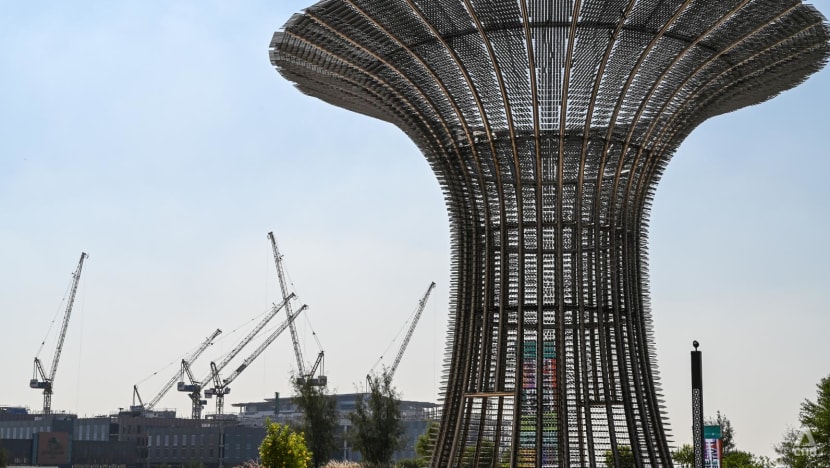Cooler commutes possible with UAE start-up's AI-powered tool providing easily accessible heat data
Abu Dhabi start-up FortyGuard is aiming to plug a major data gap for governments and businesses dealing with worsening urban heat.

Global heat is a major challenge for growing cities. (Photo: Jack Board/CNA)

This audio is generated by an AI tool.
DUBAI: Mr Jay Sadiq never planned to build a technology company. The United Arab Emirates national launched a material science company back in 2020, inspired by the cooling techniques that the city of Los Angeles was trying to implement at the time.
“LA was trying to paint roads with a white pigment to cool them down. We wanted to cool down the UAE,” he said.
But his plan for a colourless asphalt that could reduce surface temperatures of roads and buildings across the country was quickly shut down when potential clients noticed a major flaw in the plan.
“The client was asking, ‘Where are you going to put it? … You need to identify the hot areas’,” Mr Sadiq explained.
“We couldn’t find this data. And then we understood that this is a data problem.”

His Abu Dhabi-born startup, FortyGuard, is building a cloud-based artificial intelligence (AI) tool to provide high-resolution temperature data. Its name is derived from the 40 km between the earth and ozone layer, and the latter serving as a shield against the sun’s ultraviolet radiation.
“We want FortyGuard to become the Google of temperature,” he declared.
The bulk of the world’s people now live in cities, but urban design has been no match for soaring temperatures.
“It's the way we have been designing cities over the last 50 to 60 years that has led us to where we are today, of course, compounded by the impact of climate change,” said Ms Dima Zogheib, a landscape architect and an associate director at Arup, a sustainable development firm.
"We want to become the Google of temperature": This startup is trying to solve a global problem - a lack of data about where and why our cities are so hot, to make it easier to cool them down.
A TRIPLE WHAMMY FOR CITIES
If temperatures rise by 1.5 degrees Celsius – the best-case scenario under the Paris Agreement – 2.3 billion people could be vulnerable to heat waves, with the majority of them in Asia, according to the Asian Development Bank (ADB).
The current greenhouse gas emissions trajectory means three out of four people in the world will be exposed to deadly heat conditions every year by 2100, the ADB said.
The world is likely to experience a 4.7-fold increase in heat-related deaths by mid-century, according to The Lancet medical journal. Already 61,000 heat-related deaths were recorded in Europe during last year’s summer.
“It's going to make cities quite difficult to live in. The livability aspect will be compromised immensely,” said urban climate specialist Winston Chow of the Singapore Management University.
A “triple whammy” of temperature aggravators is a common dilemma for all cities, he explained.
Concrete and asphalt has replaced the natural landscape over many years, creating what is known as the urban heat island effect.
Roads, buildings and other concrete infrastructure absorb solar radiation during the day and release it slowly at night, causing an increase in temperature.

It means that in Singapore for example, urban areas can be up to seven degrees Celsius hotter than forested areas. In other parts of the world, including the Middle East, the effect can be even more extreme, straining the comfort and health of city residents.
In addition, regional and global temperatures are rising due to climate change, which is also increasing the frequency and severity of weather events like heat waves.
World leaders gathered at the 28th Conference of the Parties (COP28) in Dubai as the planet experienced its hottest year on record, and United Nations (UN) secretary-general Antonio Guterres warned humanity was “living through climate collapse in real time”.
More cities are now looking for solutions.
Heat, a “silent killer”, has been overlooked until “very recently”, noted Ms Eleni Myrivili, global chief heat officer at UN-Habitat and the Atlantic Council's Arsht-Rock Resilience Center.
Reliable and useable data showing where heat is doing the most damage, and the solutions that could be adopted, is lacking in many places around the world but FortyGuard hopes to supply some of the answers.

VISUALISING TEMPERATURE
It is not a weather or infrastructure company. Rather, it uses advanced software to couple public environmental data with satellite imagery and information from weather stations.
The information gathered is designed to be quickly accessible, far cheaper than direct satellite data and customisable to specific locations. It can provide granular details down to a 10-metre level.
“Our software has the capability to understand why a certain place is hot,” added Mr Sadiq. “What can be done to cool it down? What's the impact on the energy demand? How can we save (energy)? Or what's the impact on human thermal comfort, and how can we improve it?”
FortyGuard aims to save users time and money by removing the need to send out engineers with sensors to do physical analytics, he said.
Instead city planners or engineers would be able to “immediately visualise temperature, with the time and the location that they want”.

The start-up is focusing its attention on the United States, where it is already partnering with Rochester City in New York under a subscription plan. It plans to do similar modelling in Europe and Asia.
FortyGuard’s data is potentially useful to navigation tool developers who can guide pedestrians to take a cooler route, said Mr Sadiq.
Property listing applications could also use it to cater to homebuyers who want good microclimate conditions, while insurers and the banking, health and logistics sectors could use it to develop new products and better understand risk.
MORE TREE COVER, FEWER PAVED SURFACES
FortyGuard tested much of its data gathering and technology in an unusual desert city with ambitious architectural features, close to Abu Dhabi International Airport.
Masdar City is the green urban vision of its company namesake, which is helmed by Sultan Al Jaber, also the president of COP28 and the head of the UAE’s national oil company.
Launched in 2006, the grand idea of a zero-carbon, zero-waste metropolis has largely not been realised, except for its inner core, which comprises just 10 per cent of the city’s proposed total size.
Modelled on ancient Arab city designs, the largely empty city centre is car-free and noticeably cool.
Natural breezes funnelled by innovative building design, shadowed walkways, as well as surfaces and windows that reflect instead of absorbing solar glare keep temperatures lower than surrounding areas.
The city encourages walkability, a notion that would be unheard of elsewhere in the UAE, where daytime temperatures have exceeded 50 degrees Celsius.

Many cities have traditionally relied on air-conditioning for cooling, but such equipment represents 20 per cent of total electricity consumption today – and is expected to more than double by 2050, according to the UN Environment Programme.
At COP28, 63 nations signed up to the Global Cooling Pledge, which promises to cut cooling-related emissions, namely from refrigeration and air conditioning.

“Everything in Masdar City’s planning revolves around how to moderate heat naturally to make the outdoor environment comfortable,” said Mr Chris Wan, the city’s head of design management.
While the ambition for Masdar City to power itself with solar energy and pump its own water supply has been scrapped, there are still valuable lessons to be found here, Mr Sadiq said.
This grand-scale experiment was a tool for FortyGuard to finesse its product and ideas about what makes a city liveable. “They really enabled us to understand how to demonstrate our solution at a city level,” he said.
For existing cities grappling with urban heat, the answers can often be simple, said Ms Zogheib of Arup, which has piloted its Urban Heat Snapshot tool in six cities – Cairo, London, Los Angeles, Madrid, Mumbai and New York – to understand local heat impacts.
“First of all, we need to increase tree canopy cover. We need to de-pave and we need to start creating more permeable surfaces that water can dissipate through to minimise radiation and overheating of the surfaces. Thirdly, we need to start thinking about cool roofs,” she said, referring to roofs that reflect more sunlight and absorb less heat than conventional roofs.
“Cities are heating faster (than the rest of the world) and it's time now to take action,” she said.


















